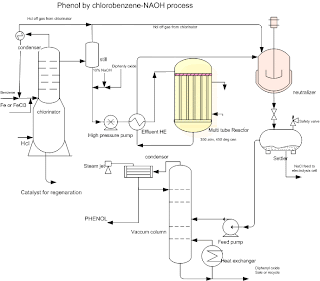
Process Description of Chlorobenzene and Caustic process for phenol production:
For 1 ton of phenol production, approximately the following raw materials are required as per the process described:
Benzene = 0.90 tons
Chlorine = 0.82 tons
NaOH = 0.67 tons
HCl = 0.51 tons
The main reactions which take place in this process are:
1. Chlorination
C6H6 + Cl2 —> 85oC , Fe- –> C6H5Cl (Chlorobenzene)
2. Causticization
C6H5Cl +NaOH (aq)—> C6H5NaO
3. Hydrolysis
C6H5NaO + HCl(aq) —- > C6H5OH + NaCl(aq)
A Short Process Description for Phenol Production:
Benzene which is in a dry state reacted with chlorine in the presence of the catalyst iron or anhydrous ferric chloride at about 85 deg centigrade temperature to form Chlorobenzene in a chlorination tower, unconverted benzene is recycled and monochlorobenzene is withdrawn from all excess chlorine is used in neutralizer and about 10% solution of dilute caustic soda is mixed with Chlorobenzene which is reacted with a caustic solution where chlorine present at the benzene ring is reacted with hydrogen and produce water vapors which are removed a tail gas. The resulting product diphenyl oxide is pumped to the preheater and then passed to the multi-tube reactor where causticization reaction occurs at the parameters 425 deg centigrade and 350 atm pressure, then the reacted mixture is passed to the neutralizer through the effluent heat exchangers.
Phenol is obtained from hydrolysis occurs at the neutralizer where a reaction with concentrated hydrochloric acid takes place to form phenol and sodium chloride.
Sodium chloride is formed as a side product, this salt is separated and sent to electrolysis.
Upstream from the separator is sent to the vacuum distillation column where phenol is stripped out. About 95% yield is obtained and diphenyl oxide is removed from the bottom of the column to recycle.
Major engineering problems in this process are:
HCl corrosion in the Chlorobenzene plant section
High-pressure vessel design for causticization reactor
Phenol Production by Benzene Sulfonation Process

Phenol Production brief process description by the Benzene Sulfonation Process technology:
Benzene can be converted to phenol with the help of inorganic acids and salts and this process is the oldest of all the processes where phenol is produced by reactants such as cumene and toluene.
This process involves four major chemical reactions which are:
Sulfonation: Benzene is reacted with sulphuric acid to form benzene sulphonic acid at 150 to 170 deg centigrade
Neutralization: Benzene sulphonic acid is reacted with sodium sulfite to form sodium benzene sulphonate
Fusion: Sodium benzene sulphonate is fused with sodium hydroxide to form sodium phenoxide
Acidification: sulphuric acid and sodium phenoxide are reacted to produce crude phenol and sodium sulfite.
The above reaction step explains the requirement of the unit operation equipment in the process as
- Filtration: Pressure filter and centrifuge used in the separation of sodium sulfate and sodium sulfite
- Distillation: Separation of phenol from crude phenol
- Crystallization: Separation and recovery of sodium sulphite
Process description: This process is a large-scale batch cycle operation due to the slow reaction step at fusionator. Sodium benzene sulphonate is fed to cast iron make fusion pots which already contain molten caustic soda at a temperature of 300 deg centigrade, due to a slow reaction with taking about 5-6 hours of residence time the pot is fed at regular intervals where continuous loading and unloading of the pot occurs for continuity of the process, thus sodium phenoxide fraction which is obtained is fed to acidifier to produce crude phenol by reacting with sulphuric acid and sulfur dioxide. The vacuum distillation column is used to get phenol from crude phenol and remain salts are stripped in a steam stripper to remove phenol from them and aqueous salts. Crystallizers are used to increase the purity of the sodium sulfite; these crystals are separated from the mother slurry by a continuous centrifugal separator, which is recycled to the neutralizer.
Related Topic
- SULPHATES Determination Test | Sulphites Determination | Determination Of Sulphate And Sulphide In Water
- Petrochemical Products From Propylene | Types Of Pressure Gauges | Types Of Reactors Used For Chemical Reactions And Chemical Process
- Printing Machine And Devices | Propellers Of A Ship
- Predesulphurization Of Raw Naphtha Process Plant Flow Sheet
- Phosphoric Acid Per Day Flow Sheet Of Dihydrate Process
- Types Of Phenol Manufacturing Process
- Chlorobenzene And Caustic Process For Phenol Production | Phenol Production By Benzene Sulfonation Process
- Bin Blender Applications
- Operating Procedure For Liquid-Liquid Extraction In Packed Column
